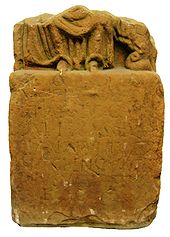Ritona

O.D. T.PRIITONAE. DI VINAE SIVE CA... IONI PRO SALVTE VICANORVM CONTI OMAGUS ENSIVMTER TINIUS MODESTVS F.C.V.S.
Ritona (also known as Pritona) is a Celtic goddess chiefly venerated in the land of the Treveri in what is now Germany. Her cult is attested at Pachten and at Trier, where she "had a carefully built little temple" in the Altbachtal complex.[1] Ritona's temple was one of several in the Altbachtal to include exedrae and courtyards that may have been used to prepare ritual banquets and/or to place offerings.[2] At Pachten her temple also had a theatre, presumably used for performances of a religious nature.[1]
Name
The theonym Ritona is generally interpreted as meaning 'that of the ford', stemming from the Gaulish root ritu- ('ford'; cf. Old Irish Humar-rith, Welsh rhyd 'ford').[3][4] This suggests that she was a goddess of fords;[5] Jean-Marie Pailler remarks that, "Water crossings required religious precautions that were written into the landscape, toponymy, and ritual: Ritona is thus well at home among the 'crossers' who were the Treveri".[6] The translation 'that of the course [of the river]' is also possible, by deriving Ritona from the homonym root ritu-, rito- ('course'; cf. Old Irish riuth, Welsh rhed 'course'), although the name Trēveri is also generally seen as meaning 'those crossing the river', that is to say the 'ferrymen'.[3]
The variant Pritona is directly attested twice: on the goddess's only inscription at Pachten (PRITONAE DIVINAE SIVE CA[...]IONI),[7] and in conjunction with ‘Ritona’ on an inscription from Trier (DEA RITONA PRITONA).[8] Pritona is also restored in a further, more fragmentary inscription from Trier (RITO/[NAE] SIVE EX IV[SSV PR]/ITONI[AE?]).[9] A single inscription also honours her at Uzès in southern France.[10]
Role
Lothar Schwinden characterizes Ritona as a mother goddess on the basis of the statue of a seated goddess found at Pachten, which he connects with the well-known local type of seated mother goddesses with dogs or babies on their laps (cf. Aveta).[11]

The Pachten inscription specifies that the goddess was invoked by an individual "for the well-being of the townsfolk of Contiomagium" (PRO SALVTE / [V]IKANORVM CONTI/OMAGIENSIVM).[7] A votive sculpture from Crain, depicting a male figure holding an offering-dish and pouring out liquid from a vessel, is dedicated to Minerva and Ritona.[12] On two of the inscriptions from Trier, Ritona is invoked in conjunction either with the numina of the Augusti (see imperial cult)[13] or in honour of the divine house (the imperial family).[14]
References
- ^ a b Edith Mary Wightman (1970). Roman Trier and the Treveri. Rupert Hart-Davis, London. p. 217.
- ^ John Scheid (1995). "Les temples de l'Altbachtal à Trèves : un "sanctuaire national"?". Cahiers du Centre Gustave Glotz. 6. Editions de Boccard: 236.
- ^ a b Delamarre 2003, pp. 259–260.
- ^ The Celtic root *ritu- is thought to derive from the same Indo-European root *pr̻tu- that gives Latin portus 'port' and English 'ford'. Lenka Dočkalová; Václav Blažek (2011). "On Indo-European Roads". The Journal of Indo-European Studies. 39 (3 & 4): 312.
- ^ Miranda Green (1997). Dictionary of Celtic Myth and Legend. Thames and Hudson Ltd. London.
- ^ Jean-Marie Pailler (2013). "Mères, Fils et confréries à l'écoute de la Source : témoignages antiques et approche par la toponymie, l'archéologie et l'épigraphie gauloises". AFEAF: 321. Original quote: Les passages de cours d’eau nécessitaient des précautions religieuses inscrites dans le paysage, la toponymie, le rituel : Ritona est ainsi bien à sa place chez les “passeurs” que sont les Trévires.
- ^ a b AE 1959, 00076, retrieved from the Epigraphik-Datenbank Clauss / Slaby Archived 2008-04-09 at the Wayback Machine on 29 March 2008.
- ^ AE 1928, 00185, retrieved from the Epigraphik-Datenbank Clauss / Slaby Archived 2008-04-09 at the Wayback Machine on 29 March 2008.
- ^ AE 1989, 00547, retrieved from the Epigraphik-Datenbank Clauss / Slaby Archived 2008-04-09 at the Wayback Machine on 29 March 2008.
- ^ CIL XII, 02927, retrieved from the Epigraphik-Datenbank Clauss / Slaby Archived 2008-04-09 at the Wayback Machine on 29 March 2008.
- ^ Lothar Schwinden. "Muttergöttin der Treverer: Ritona". In Sabine Faust et al. (1996) Religio Romana: Wege zu den Göttern im antiken Trier. Rheinisches Landesmuseum Trier.
- ^ CIL XIII, 02892, retrieved 3 May 2016.
- ^ AE 1989, 00547, retrieved from the Epigraphik-Datenbank Clauss / Slaby Archived 2008-04-09 at the Wayback Machine on 29 March 2008.
- ^ Finke 00030, retrieved from the Epigraphik-Datenbank Clauss / Slaby Archived 2008-04-09 at the Wayback Machine on 29 March 2008.
- Bibliography
- Delamarre, Xavier (2003). Dictionnaire de la langue gauloise: Une approche linguistique du vieux-celtique continental. Errance. ISBN 9782877723695.
- v
- t
- e
- Alaunus
- Alisanos
- Andarta
- Anextiomarus
- Artio
- Aveta
- Belenus
- Belisama
- Borvo
- Brigantia
- Camulus
- Cernunnos
- Cicolluis
- Cissonius
- Condatis
- Damona
- Dis Pater
- Divona
- Epona
- Erecura
- Esus
- Genii Cucullati
- Grannus
- Ialonus Contrebis
- Lenus
- Litavis
- Loucetios
- Lugus
- Maponos
- Matres
- Matrona
- Mogons
- Nantosuelta
- Ogmios
- Ritona
- Rosmerta
- Segomo
- Sirona
- Sucellus
- Suleviae
- Taranis
- Telesphorus
- Toutatis
- Virotutis
- Visucius


- Abellio
- Baco
- Fagus
- Sexarbores
- Albiorix
- Artaius
- Buxenus
- Cathubodua
- Lero et Lerina
- Nemausus
- Rudianos
- Bandua
- Endovelicus
- Nabia
- Reue











